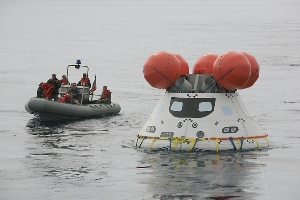Aug 8 2014
A team of technicians, engineers, sailors and divers just wrapped up a successful week of testing and preparing for various scenarios that could play out when NASA's new Orion spacecraft splashes into the Pacific Ocean following its first space flight test in December.
 U.S. Navy personnel use a rigid hull inflatable boat to approach the Orion boilerplate test article during an evolution of the Underway Recovery Test 2 in the Pacific Ocean off the coast of San Diego, California on Aug. 2, 2014. Image Credit: NASA/Kim Shiflett
U.S. Navy personnel use a rigid hull inflatable boat to approach the Orion boilerplate test article during an evolution of the Underway Recovery Test 2 in the Pacific Ocean off the coast of San Diego, California on Aug. 2, 2014. Image Credit: NASA/Kim Shiflett
After enduring the extreme environment of space, Orion will blaze back through Earth's atmosphere at speeds near 20,000 mph and temperatures approaching 4,000 degrees Fahrenheit. Its inaugural journey will end in the Pacific, off the Southern California coast, where a U.S. Navy ship will be waiting to retrieve it and return it to shore.
"We learned a lot about our hardware, gathered good data, and the test objectives were achieved,” said Mike Generale, NASA recovery operations manager in the Ground Systems Development and Operations Program. “We were able to put Orion out to sea and safely bring it back multiple times. We are ready to move on to the next step of our testing with a full dress rehearsal landing simulation on the next test."
NASA and Orion prime contractor Lockheed Martin teamed up with the U.S. Navy and the Defense Department's Human Space Flight Support Detachment 3 to try different techniques for recovering the 20,500-pound spacecraft safely during this second "underway recovery test." To address some of the lessons learned from the first recovery test in February, the team brought new hardware to test and tested a secondary recovery method that employs an onboard crane to recover Orion, as an alternative to using the well deck recovery method, which involves the spacecraft being winched into a flooded portion of the naval vessel.
"Anchorage provided a unique, validated capability to support NASA's request for operational support without adversely impacting the Navy's primary warfighting mission," said Cmdr. Joel Stewart, commanding officer of the Navy vessel. "This unique mission gave Anchorage sailors an opportunity to hone their skills for the routine missions of recovering vehicles in the well deck and operating rigid-hulled inflatable boats in the open water while supporting NASA. The testing with NASA was a success and Anchorage sailors continue to raise the bar, completing missions above and beyond any expectations."
Learn more about Orion at: http://www.nasa.gov/orion
Learn more about NASA's Ground Systems Development and Operations Program at: http://go.nasa.gov/groundsystems